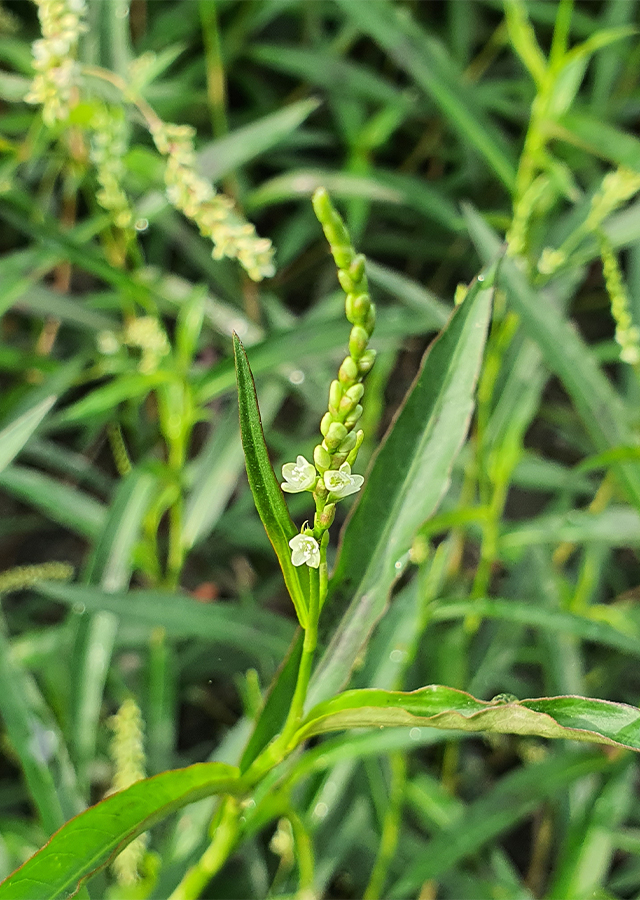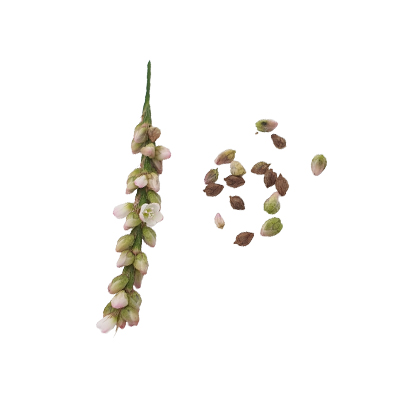Joint weed
Persicaria barbata (L.) H.Hara
Polygonaceae
Location in our garden
Principal



Synonym
Persicaria barbata var. hirtella (Meisn.) M.A.Hassan
Persicaria kotoshoensis (Ohki) Sasaki
Persicaria omerostroma (Ohki) Sasaki
Habitus
Herbaceous. Perennial herb, slightly hairy plant, growing to a height of 40 to 80 m
Part Used
Seeds
The Whole Plant
Rhizome
Growing Requirements
Full Sunshine
Habitat
Riverbanks
Overview
Its native range is Arabian Peninsula, tropical and subtropical Asia. Also occurs in Africa, India, Malaya, Bangladesh, Thailand, and in many other countries in South-East Asia. The plant is sometimes gathered from the wild and used locally as a food and medicine.
Vernacular Names
Subsuban (Philippines), Mao liao (Chinese), Tebok seludang (Malaysia), Konde malle (India), Kating he (Cambodia).
Agroecology
Often found along rivers and ditches in soggy sunny localities, from sea-level up to 1200 m altitude. Succeeds in an ordinary garden soil but prefers a moisture retentive not too fertile soil in sun or part shade.
Morphology
- Stems - stem slender, robust, erect or semi-procumbent, stems creeping to ascending to erect, hairy upwards or throughout, loosely branched, 40-80 cm tall.
- Leaves - elliptic to lanceolate 10 to 15 cm long, glabrous or almost glabrous above, with appressed hairs on the lower surface, petiole short, apex acuminate, often with a brown blotch, appressed pubescent on either surface, at least on the veins, base acute, rarely rounded or cordate.
- Flowers - pedicellate in fascicles of 1–3 flowers, 2—3.3 mm long and without glands, white, greenish white or pink, not accrescent after anthesis, stamens 6—7, styles
- Fuits - nutlet trigonous, 1.7 mm long, smooth and shiny, black, usually with the faces concave.
Cultivation
- By seeds - sow in situ.
- By division - very easy, larger divisions can be planted out direct into their permanent positions. It is better to pot up the smaller divisions and grow them on in light shade until they are well established before planting them out
Chemical Constituents
Sitosterone, viscozulenic acid, acetophenone, flavanones, terpenoids, sterols, mucilage, glycosides, alkaloids, steroidal saponins.
Traditional Medicinal Uses
- Considered anti-ulcer, wound healing, antimicrobial, analgesic, anti-inflammatory, antiproliferative properties, astringent and cooling.
- Study evaluated a leaf extract for antioxidant activity.
- Seeds are antiemetic, purgative, stimulant properties and can be used to relieve colic pain, for treatment of dysentery and cholera, in Malabar and Canara, seeds are also used to relieve colic pains.
- In northern India, the dried rhizome is employed as an astringent and cooling medicine.
- In China, decoction of leaves and stems used to wash wounds and ulcers.
- Sap of pounded leaves applied to wounds is considered an effective cicatrizant.
- Roots are used as astringent.
- Paste of roots is used for treatment of scabies.
- The plant juice is used as anthelmintic, diuretic, carminative and also can be used for itchiness.
- Shoots extracts can be used for washing ulcer wounds.
Part Used
Reference Sources
- Do, N.T., 2001. Persicaria barbata (L.) H. Hara. In: van Valkenburg, J.L.C.H. and Bunyapraphatsara, N. (Editors): Plant Resources of South-East Asia No 12(2): Medicinal and poisonous plants 2. PROSEA Foundation, Bogor, Indonesia. Database record: prota4u.org/prosea.
- https://powo.science.kew.org/taxon/urn:lsid:ipni.org:names:694917-1 diakses tanggal 25 November 2021



